Analysis of Performance Management Models, Roles, and HR Relationship
VerifiedAdded on 2020/01/07
|17
|5961
|177
Report
AI Summary
This report delves into the multifaceted realm of performance management, examining its core principles and practices. It begins by defining performance management and highlighting key messages, followed by a critical analysis of various models, including McGregor's theory and appreciative inquiry. The report then investigates the roles of managers and HR representatives in performance management, evaluating their relationship and how an effective collaboration can enhance organizational effectiveness. The analysis covers the benefits, limitations, and overlaps of these roles, providing insights into how to align employee efforts with business objectives, foster motivation, and drive overall success. The report underscores the importance of communication, setting achievable benchmarks, and the continuous development of employees to meet organizational goals. The report also touches upon key practices of performance management and scrutinizes the relationship with HR representatives in the management of employee's performance as a mean of achieving success in the organization.
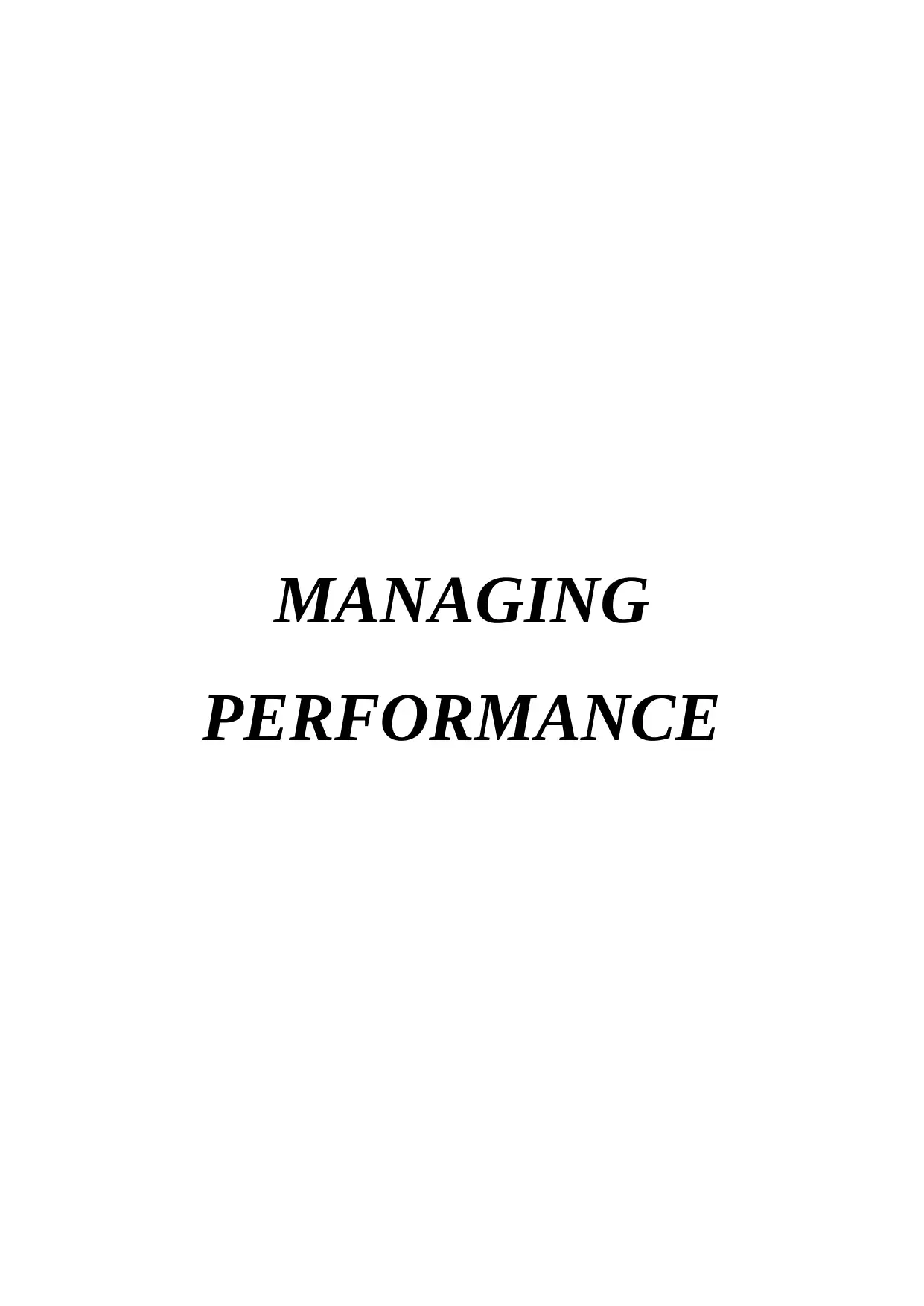
MANAGING
PERFORMANCE
PERFORMANCE
Paraphrase This Document
Need a fresh take? Get an instant paraphrase of this document with our AI Paraphraser
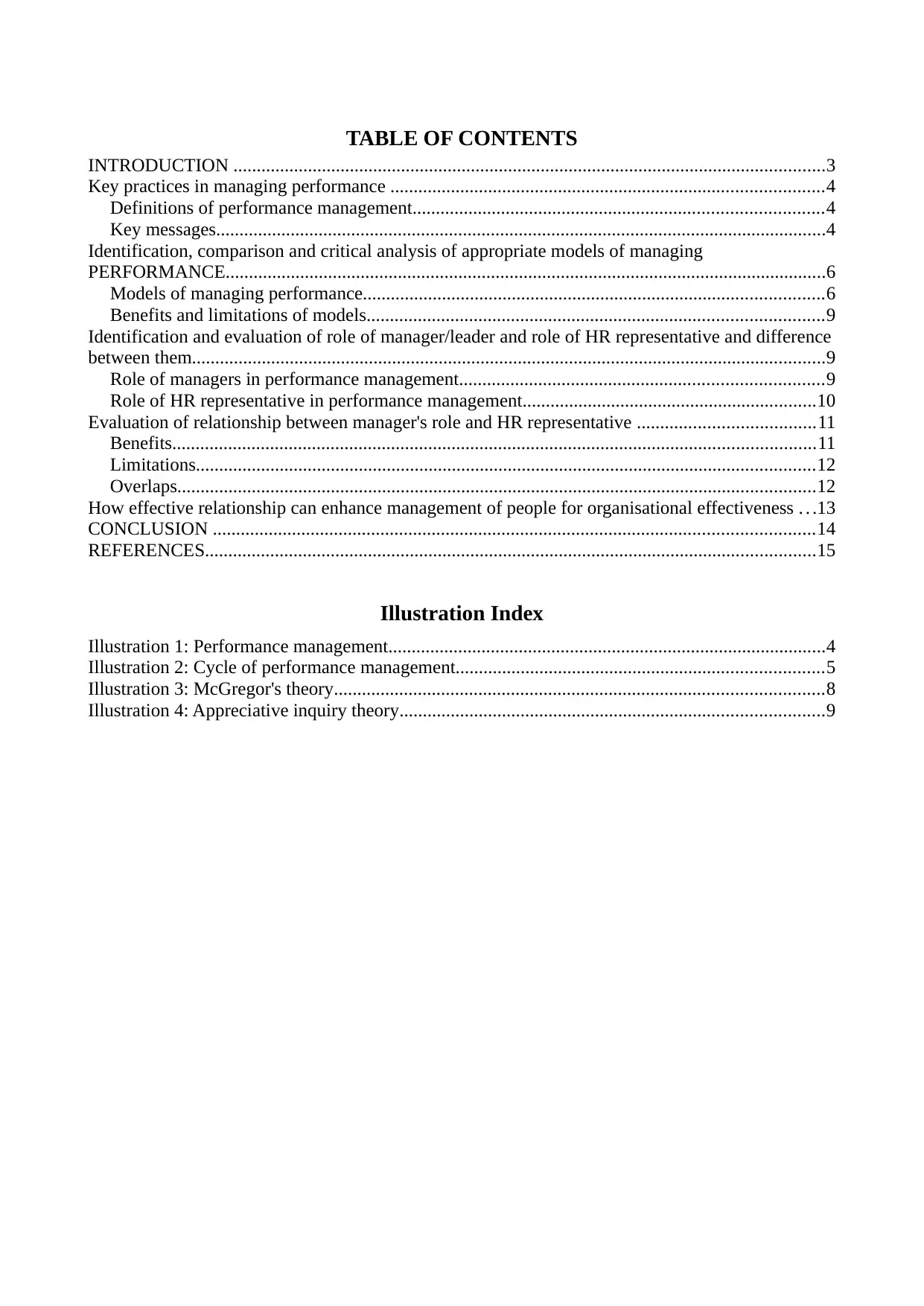
TABLE OF CONTENTS
INTRODUCTION ...............................................................................................................................3
Key practices in managing performance .............................................................................................4
Definitions of performance management........................................................................................4
Key messages...................................................................................................................................4
Identification, comparison and critical analysis of appropriate models of managing
PERFORMANCE.................................................................................................................................6
Models of managing performance...................................................................................................6
Benefits and limitations of models..................................................................................................9
Identification and evaluation of role of manager/leader and role of HR representative and difference
between them........................................................................................................................................9
Role of managers in performance management..............................................................................9
Role of HR representative in performance management...............................................................10
Evaluation of relationship between manager's role and HR representative ......................................11
Benefits..........................................................................................................................................11
Limitations.....................................................................................................................................12
Overlaps.........................................................................................................................................12
How effective relationship can enhance management of people for organisational effectiveness . . .13
CONCLUSION .................................................................................................................................14
REFERENCES...................................................................................................................................15
Illustration Index
Illustration 1: Performance management..............................................................................................4
Illustration 2: Cycle of performance management...............................................................................5
Illustration 3: McGregor's theory.........................................................................................................8
Illustration 4: Appreciative inquiry theory...........................................................................................9
INTRODUCTION ...............................................................................................................................3
Key practices in managing performance .............................................................................................4
Definitions of performance management........................................................................................4
Key messages...................................................................................................................................4
Identification, comparison and critical analysis of appropriate models of managing
PERFORMANCE.................................................................................................................................6
Models of managing performance...................................................................................................6
Benefits and limitations of models..................................................................................................9
Identification and evaluation of role of manager/leader and role of HR representative and difference
between them........................................................................................................................................9
Role of managers in performance management..............................................................................9
Role of HR representative in performance management...............................................................10
Evaluation of relationship between manager's role and HR representative ......................................11
Benefits..........................................................................................................................................11
Limitations.....................................................................................................................................12
Overlaps.........................................................................................................................................12
How effective relationship can enhance management of people for organisational effectiveness . . .13
CONCLUSION .................................................................................................................................14
REFERENCES...................................................................................................................................15
Illustration Index
Illustration 1: Performance management..............................................................................................4
Illustration 2: Cycle of performance management...............................................................................5
Illustration 3: McGregor's theory.........................................................................................................8
Illustration 4: Appreciative inquiry theory...........................................................................................9
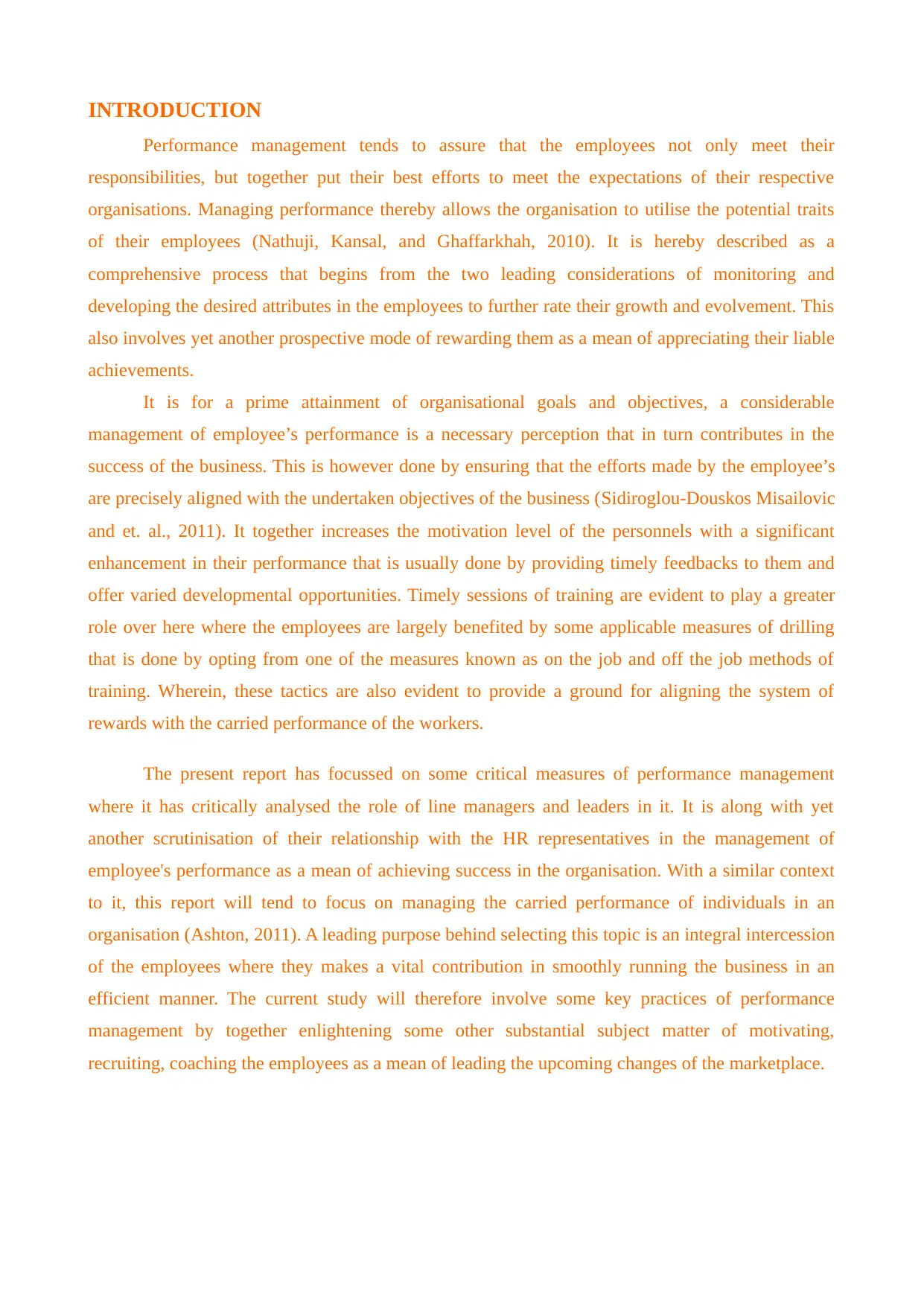
INTRODUCTION
Performance management tends to assure that the employees not only meet their
responsibilities, but together put their best efforts to meet the expectations of their respective
organisations. Managing performance thereby allows the organisation to utilise the potential traits
of their employees (Nathuji, Kansal, and Ghaffarkhah, 2010). It is hereby described as a
comprehensive process that begins from the two leading considerations of monitoring and
developing the desired attributes in the employees to further rate their growth and evolvement. This
also involves yet another prospective mode of rewarding them as a mean of appreciating their liable
achievements.
It is for a prime attainment of organisational goals and objectives, a considerable
management of employee’s performance is a necessary perception that in turn contributes in the
success of the business. This is however done by ensuring that the efforts made by the employee’s
are precisely aligned with the undertaken objectives of the business (Sidiroglou-Douskos Misailovic
and et. al., 2011). It together increases the motivation level of the personnels with a significant
enhancement in their performance that is usually done by providing timely feedbacks to them and
offer varied developmental opportunities. Timely sessions of training are evident to play a greater
role over here where the employees are largely benefited by some applicable measures of drilling
that is done by opting from one of the measures known as on the job and off the job methods of
training. Wherein, these tactics are also evident to provide a ground for aligning the system of
rewards with the carried performance of the workers.
The present report has focussed on some critical measures of performance management
where it has critically analysed the role of line managers and leaders in it. It is along with yet
another scrutinisation of their relationship with the HR representatives in the management of
employee's performance as a mean of achieving success in the organisation. With a similar context
to it, this report will tend to focus on managing the carried performance of individuals in an
organisation (Ashton, 2011). A leading purpose behind selecting this topic is an integral intercession
of the employees where they makes a vital contribution in smoothly running the business in an
efficient manner. The current study will therefore involve some key practices of performance
management by together enlightening some other substantial subject matter of motivating,
recruiting, coaching the employees as a mean of leading the upcoming changes of the marketplace.
Performance management tends to assure that the employees not only meet their
responsibilities, but together put their best efforts to meet the expectations of their respective
organisations. Managing performance thereby allows the organisation to utilise the potential traits
of their employees (Nathuji, Kansal, and Ghaffarkhah, 2010). It is hereby described as a
comprehensive process that begins from the two leading considerations of monitoring and
developing the desired attributes in the employees to further rate their growth and evolvement. This
also involves yet another prospective mode of rewarding them as a mean of appreciating their liable
achievements.
It is for a prime attainment of organisational goals and objectives, a considerable
management of employee’s performance is a necessary perception that in turn contributes in the
success of the business. This is however done by ensuring that the efforts made by the employee’s
are precisely aligned with the undertaken objectives of the business (Sidiroglou-Douskos Misailovic
and et. al., 2011). It together increases the motivation level of the personnels with a significant
enhancement in their performance that is usually done by providing timely feedbacks to them and
offer varied developmental opportunities. Timely sessions of training are evident to play a greater
role over here where the employees are largely benefited by some applicable measures of drilling
that is done by opting from one of the measures known as on the job and off the job methods of
training. Wherein, these tactics are also evident to provide a ground for aligning the system of
rewards with the carried performance of the workers.
The present report has focussed on some critical measures of performance management
where it has critically analysed the role of line managers and leaders in it. It is along with yet
another scrutinisation of their relationship with the HR representatives in the management of
employee's performance as a mean of achieving success in the organisation. With a similar context
to it, this report will tend to focus on managing the carried performance of individuals in an
organisation (Ashton, 2011). A leading purpose behind selecting this topic is an integral intercession
of the employees where they makes a vital contribution in smoothly running the business in an
efficient manner. The current study will therefore involve some key practices of performance
management by together enlightening some other substantial subject matter of motivating,
recruiting, coaching the employees as a mean of leading the upcoming changes of the marketplace.
⊘ This is a preview!⊘
Do you want full access?
Subscribe today to unlock all pages.

Trusted by 1+ million students worldwide
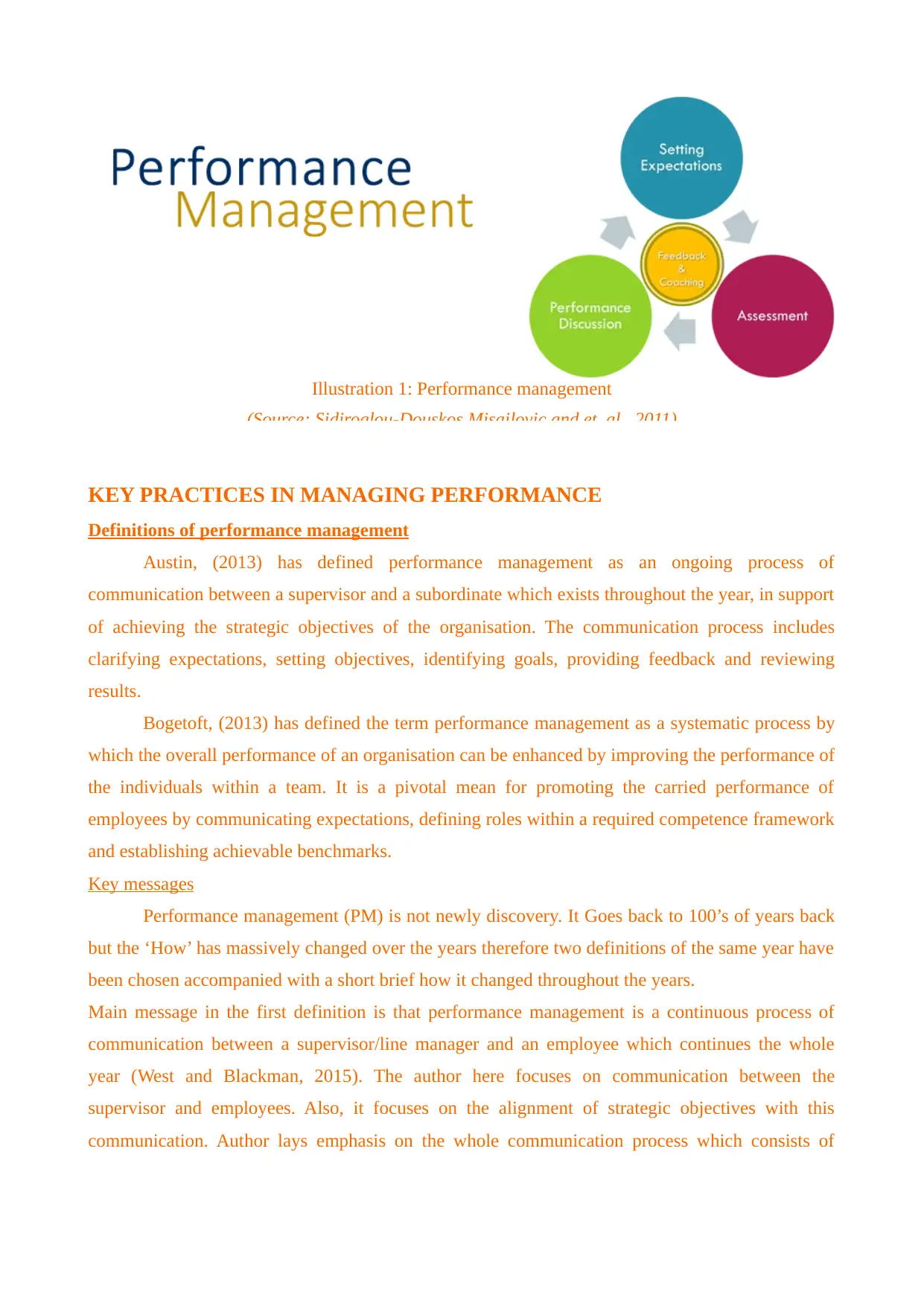
KEY PRACTICES IN MANAGING PERFORMANCE
Definitions of performance management
Austin, (2013) has defined performance management as an ongoing process of
communication between a supervisor and a subordinate which exists throughout the year, in support
of achieving the strategic objectives of the organisation. The communication process includes
clarifying expectations, setting objectives, identifying goals, providing feedback and reviewing
results.
Bogetoft, (2013) has defined the term performance management as a systematic process by
which the overall performance of an organisation can be enhanced by improving the performance of
the individuals within a team. It is a pivotal mean for promoting the carried performance of
employees by communicating expectations, defining roles within a required competence framework
and establishing achievable benchmarks.
Key messages
Performance management (PM) is not newly discovery. It Goes back to 100’s of years back
but the ‘How’ has massively changed over the years therefore two definitions of the same year have
been chosen accompanied with a short brief how it changed throughout the years.
Main message in the first definition is that performance management is a continuous process of
communication between a supervisor/line manager and an employee which continues the whole
year (West and Blackman, 2015). The author here focuses on communication between the
supervisor and employees. Also, it focuses on the alignment of strategic objectives with this
communication. Author lays emphasis on the whole communication process which consists of
Illustration 1: Performance management
(Source: Sidiroglou-Douskos Misailovic and et. al., 2011)
Definitions of performance management
Austin, (2013) has defined performance management as an ongoing process of
communication between a supervisor and a subordinate which exists throughout the year, in support
of achieving the strategic objectives of the organisation. The communication process includes
clarifying expectations, setting objectives, identifying goals, providing feedback and reviewing
results.
Bogetoft, (2013) has defined the term performance management as a systematic process by
which the overall performance of an organisation can be enhanced by improving the performance of
the individuals within a team. It is a pivotal mean for promoting the carried performance of
employees by communicating expectations, defining roles within a required competence framework
and establishing achievable benchmarks.
Key messages
Performance management (PM) is not newly discovery. It Goes back to 100’s of years back
but the ‘How’ has massively changed over the years therefore two definitions of the same year have
been chosen accompanied with a short brief how it changed throughout the years.
Main message in the first definition is that performance management is a continuous process of
communication between a supervisor/line manager and an employee which continues the whole
year (West and Blackman, 2015). The author here focuses on communication between the
supervisor and employees. Also, it focuses on the alignment of strategic objectives with this
communication. Author lays emphasis on the whole communication process which consists of
Illustration 1: Performance management
(Source: Sidiroglou-Douskos Misailovic and et. al., 2011)
Paraphrase This Document
Need a fresh take? Get an instant paraphrase of this document with our AI Paraphraser
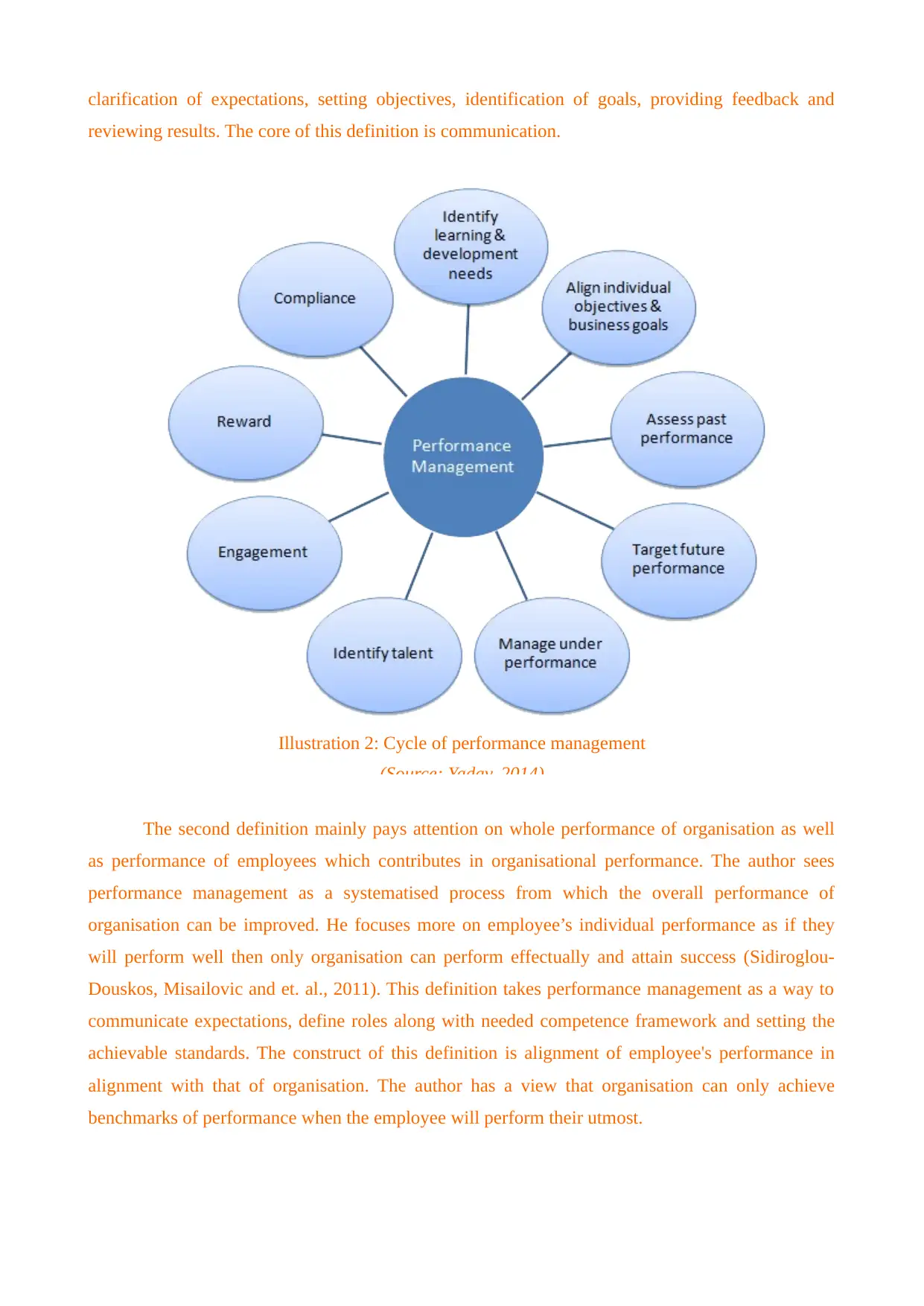
clarification of expectations, setting objectives, identification of goals, providing feedback and
reviewing results. The core of this definition is communication.
The second definition mainly pays attention on whole performance of organisation as well
as performance of employees which contributes in organisational performance. The author sees
performance management as a systematised process from which the overall performance of
organisation can be improved. He focuses more on employee’s individual performance as if they
will perform well then only organisation can perform effectually and attain success (Sidiroglou-
Douskos, Misailovic and et. al., 2011). This definition takes performance management as a way to
communicate expectations, define roles along with needed competence framework and setting the
achievable standards. The construct of this definition is alignment of employee's performance in
alignment with that of organisation. The author has a view that organisation can only achieve
benchmarks of performance when the employee will perform their utmost.
Illustration 2: Cycle of performance management
(Source: Yadav, 2014)
reviewing results. The core of this definition is communication.
The second definition mainly pays attention on whole performance of organisation as well
as performance of employees which contributes in organisational performance. The author sees
performance management as a systematised process from which the overall performance of
organisation can be improved. He focuses more on employee’s individual performance as if they
will perform well then only organisation can perform effectually and attain success (Sidiroglou-
Douskos, Misailovic and et. al., 2011). This definition takes performance management as a way to
communicate expectations, define roles along with needed competence framework and setting the
achievable standards. The construct of this definition is alignment of employee's performance in
alignment with that of organisation. The author has a view that organisation can only achieve
benchmarks of performance when the employee will perform their utmost.
Illustration 2: Cycle of performance management
(Source: Yadav, 2014)
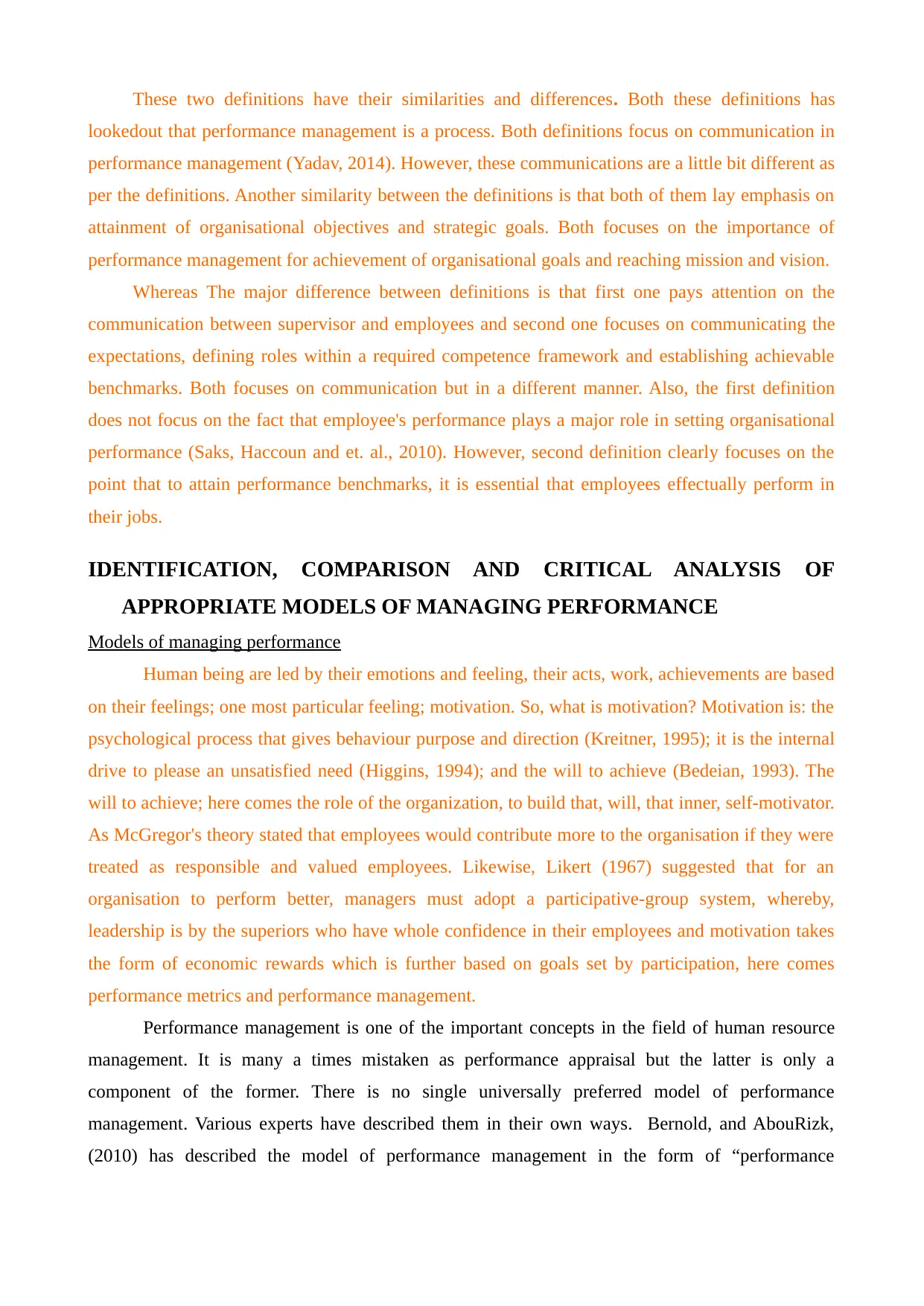
These two definitions have their similarities and differences. Both these definitions has
lookedout that performance management is a process. Both definitions focus on communication in
performance management (Yadav, 2014). However, these communications are a little bit different as
per the definitions. Another similarity between the definitions is that both of them lay emphasis on
attainment of organisational objectives and strategic goals. Both focuses on the importance of
performance management for achievement of organisational goals and reaching mission and vision.
Whereas The major difference between definitions is that first one pays attention on the
communication between supervisor and employees and second one focuses on communicating the
expectations, defining roles within a required competence framework and establishing achievable
benchmarks. Both focuses on communication but in a different manner. Also, the first definition
does not focus on the fact that employee's performance plays a major role in setting organisational
performance (Saks, Haccoun and et. al., 2010). However, second definition clearly focuses on the
point that to attain performance benchmarks, it is essential that employees effectually perform in
their jobs.
IDENTIFICATION, COMPARISON AND CRITICAL ANALYSIS OF
APPROPRIATE MODELS OF MANAGING PERFORMANCE
Models of managing performance
Human being are led by their emotions and feeling, their acts, work, achievements are based
on their feelings; one most particular feeling; motivation. So, what is motivation? Motivation is: the
psychological process that gives behaviour purpose and direction (Kreitner, 1995); it is the internal
drive to please an unsatisfied need (Higgins, 1994); and the will to achieve (Bedeian, 1993). The
will to achieve; here comes the role of the organization, to build that, will, that inner, self-motivator.
As McGregor's theory stated that employees would contribute more to the organisation if they were
treated as responsible and valued employees. Likewise, Likert (1967) suggested that for an
organisation to perform better, managers must adopt a participative-group system, whereby,
leadership is by the superiors who have whole confidence in their employees and motivation takes
the form of economic rewards which is further based on goals set by participation, here comes
performance metrics and performance management.
Performance management is one of the important concepts in the field of human resource
management. It is many a times mistaken as performance appraisal but the latter is only a
component of the former. There is no single universally preferred model of performance
management. Various experts have described them in their own ways. Bernold, and AbouRizk,
(2010) has described the model of performance management in the form of “performance
lookedout that performance management is a process. Both definitions focus on communication in
performance management (Yadav, 2014). However, these communications are a little bit different as
per the definitions. Another similarity between the definitions is that both of them lay emphasis on
attainment of organisational objectives and strategic goals. Both focuses on the importance of
performance management for achievement of organisational goals and reaching mission and vision.
Whereas The major difference between definitions is that first one pays attention on the
communication between supervisor and employees and second one focuses on communicating the
expectations, defining roles within a required competence framework and establishing achievable
benchmarks. Both focuses on communication but in a different manner. Also, the first definition
does not focus on the fact that employee's performance plays a major role in setting organisational
performance (Saks, Haccoun and et. al., 2010). However, second definition clearly focuses on the
point that to attain performance benchmarks, it is essential that employees effectually perform in
their jobs.
IDENTIFICATION, COMPARISON AND CRITICAL ANALYSIS OF
APPROPRIATE MODELS OF MANAGING PERFORMANCE
Models of managing performance
Human being are led by their emotions and feeling, their acts, work, achievements are based
on their feelings; one most particular feeling; motivation. So, what is motivation? Motivation is: the
psychological process that gives behaviour purpose and direction (Kreitner, 1995); it is the internal
drive to please an unsatisfied need (Higgins, 1994); and the will to achieve (Bedeian, 1993). The
will to achieve; here comes the role of the organization, to build that, will, that inner, self-motivator.
As McGregor's theory stated that employees would contribute more to the organisation if they were
treated as responsible and valued employees. Likewise, Likert (1967) suggested that for an
organisation to perform better, managers must adopt a participative-group system, whereby,
leadership is by the superiors who have whole confidence in their employees and motivation takes
the form of economic rewards which is further based on goals set by participation, here comes
performance metrics and performance management.
Performance management is one of the important concepts in the field of human resource
management. It is many a times mistaken as performance appraisal but the latter is only a
component of the former. There is no single universally preferred model of performance
management. Various experts have described them in their own ways. Bernold, and AbouRizk,
(2010) has described the model of performance management in the form of “performance
⊘ This is a preview!⊘
Do you want full access?
Subscribe today to unlock all pages.

Trusted by 1+ million students worldwide
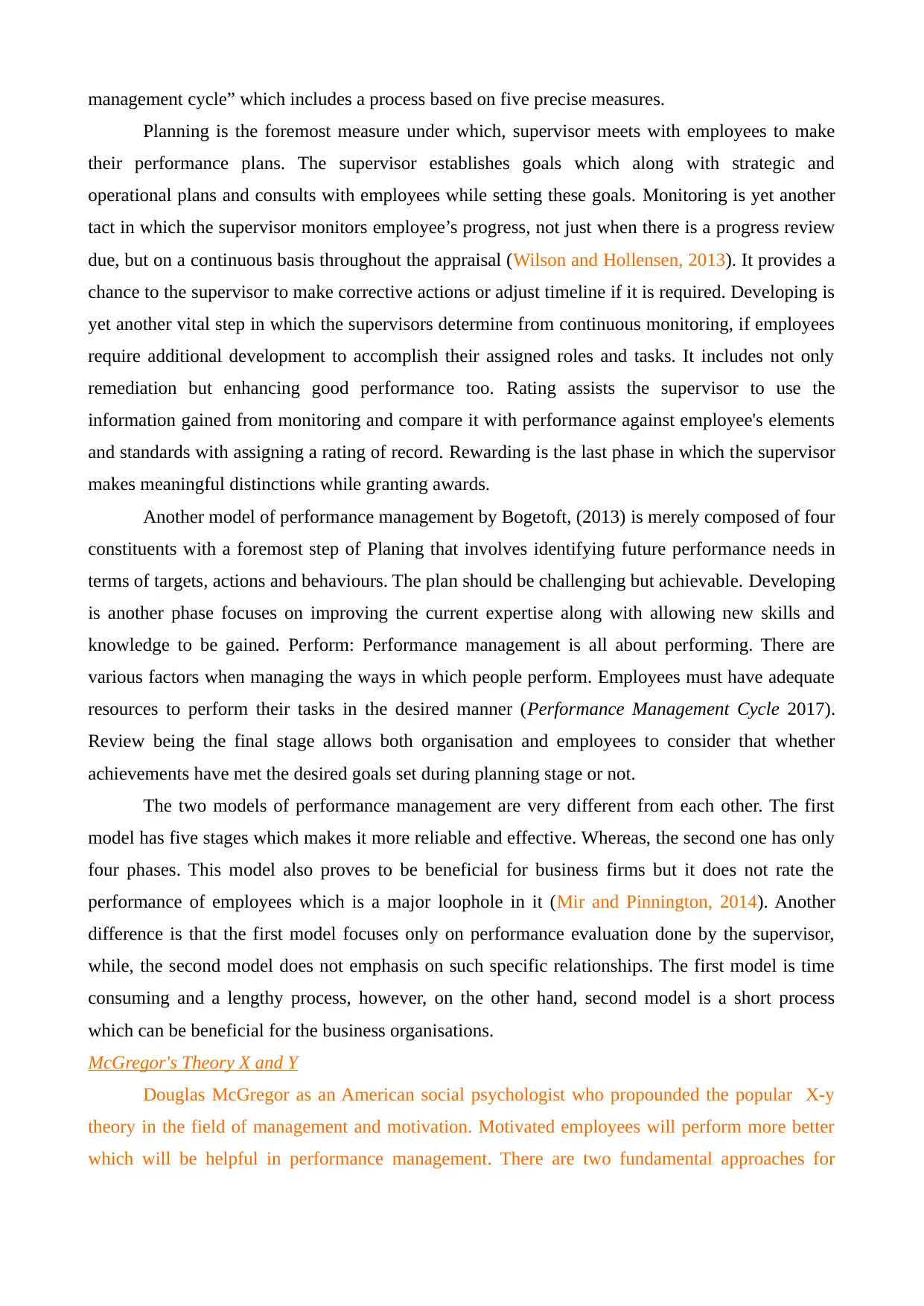
management cycle” which includes a process based on five precise measures.
Planning is the foremost measure under which, supervisor meets with employees to make
their performance plans. The supervisor establishes goals which along with strategic and
operational plans and consults with employees while setting these goals. Monitoring is yet another
tact in which the supervisor monitors employee’s progress, not just when there is a progress review
due, but on a continuous basis throughout the appraisal (Wilson and Hollensen, 2013). It provides a
chance to the supervisor to make corrective actions or adjust timeline if it is required. Developing is
yet another vital step in which the supervisors determine from continuous monitoring, if employees
require additional development to accomplish their assigned roles and tasks. It includes not only
remediation but enhancing good performance too. Rating assists the supervisor to use the
information gained from monitoring and compare it with performance against employee's elements
and standards with assigning a rating of record. Rewarding is the last phase in which the supervisor
makes meaningful distinctions while granting awards.
Another model of performance management by Bogetoft, (2013) is merely composed of four
constituents with a foremost step of Planing that involves identifying future performance needs in
terms of targets, actions and behaviours. The plan should be challenging but achievable. Developing
is another phase focuses on improving the current expertise along with allowing new skills and
knowledge to be gained. Perform: Performance management is all about performing. There are
various factors when managing the ways in which people perform. Employees must have adequate
resources to perform their tasks in the desired manner (Performance Management Cycle 2017).
Review being the final stage allows both organisation and employees to consider that whether
achievements have met the desired goals set during planning stage or not.
The two models of performance management are very different from each other. The first
model has five stages which makes it more reliable and effective. Whereas, the second one has only
four phases. This model also proves to be beneficial for business firms but it does not rate the
performance of employees which is a major loophole in it (Mir and Pinnington, 2014). Another
difference is that the first model focuses only on performance evaluation done by the supervisor,
while, the second model does not emphasis on such specific relationships. The first model is time
consuming and a lengthy process, however, on the other hand, second model is a short process
which can be beneficial for the business organisations.
McGregor's Theory X and Y
Douglas McGregor as an American social psychologist who propounded the popular X-y
theory in the field of management and motivation. Motivated employees will perform more better
which will be helpful in performance management. There are two fundamental approaches for
Planning is the foremost measure under which, supervisor meets with employees to make
their performance plans. The supervisor establishes goals which along with strategic and
operational plans and consults with employees while setting these goals. Monitoring is yet another
tact in which the supervisor monitors employee’s progress, not just when there is a progress review
due, but on a continuous basis throughout the appraisal (Wilson and Hollensen, 2013). It provides a
chance to the supervisor to make corrective actions or adjust timeline if it is required. Developing is
yet another vital step in which the supervisors determine from continuous monitoring, if employees
require additional development to accomplish their assigned roles and tasks. It includes not only
remediation but enhancing good performance too. Rating assists the supervisor to use the
information gained from monitoring and compare it with performance against employee's elements
and standards with assigning a rating of record. Rewarding is the last phase in which the supervisor
makes meaningful distinctions while granting awards.
Another model of performance management by Bogetoft, (2013) is merely composed of four
constituents with a foremost step of Planing that involves identifying future performance needs in
terms of targets, actions and behaviours. The plan should be challenging but achievable. Developing
is another phase focuses on improving the current expertise along with allowing new skills and
knowledge to be gained. Perform: Performance management is all about performing. There are
various factors when managing the ways in which people perform. Employees must have adequate
resources to perform their tasks in the desired manner (Performance Management Cycle 2017).
Review being the final stage allows both organisation and employees to consider that whether
achievements have met the desired goals set during planning stage or not.
The two models of performance management are very different from each other. The first
model has five stages which makes it more reliable and effective. Whereas, the second one has only
four phases. This model also proves to be beneficial for business firms but it does not rate the
performance of employees which is a major loophole in it (Mir and Pinnington, 2014). Another
difference is that the first model focuses only on performance evaluation done by the supervisor,
while, the second model does not emphasis on such specific relationships. The first model is time
consuming and a lengthy process, however, on the other hand, second model is a short process
which can be beneficial for the business organisations.
McGregor's Theory X and Y
Douglas McGregor as an American social psychologist who propounded the popular X-y
theory in the field of management and motivation. Motivated employees will perform more better
which will be helpful in performance management. There are two fundamental approaches for
Paraphrase This Document
Need a fresh take? Get an instant paraphrase of this document with our AI Paraphraser
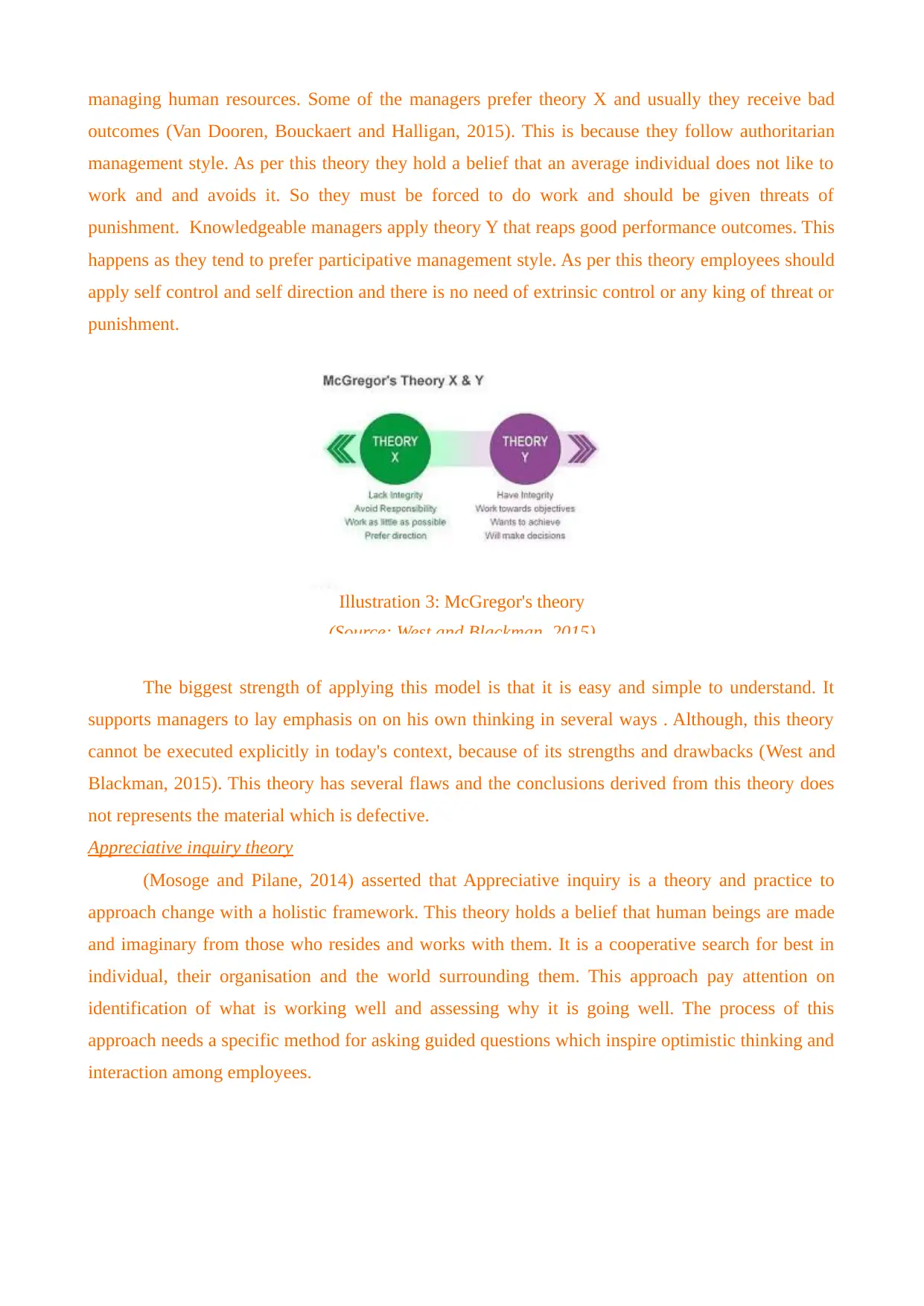
managing human resources. Some of the managers prefer theory X and usually they receive bad
outcomes (Van Dooren, Bouckaert and Halligan, 2015). This is because they follow authoritarian
management style. As per this theory they hold a belief that an average individual does not like to
work and and avoids it. So they must be forced to do work and should be given threats of
punishment. Knowledgeable managers apply theory Y that reaps good performance outcomes. This
happens as they tend to prefer participative management style. As per this theory employees should
apply self control and self direction and there is no need of extrinsic control or any king of threat or
punishment.
The biggest strength of applying this model is that it is easy and simple to understand. It
supports managers to lay emphasis on on his own thinking in several ways . Although, this theory
cannot be executed explicitly in today's context, because of its strengths and drawbacks (West and
Blackman, 2015). This theory has several flaws and the conclusions derived from this theory does
not represents the material which is defective.
Appreciative inquiry theory
(Mosoge and Pilane, 2014) asserted that Appreciative inquiry is a theory and practice to
approach change with a holistic framework. This theory holds a belief that human beings are made
and imaginary from those who resides and works with them. It is a cooperative search for best in
individual, their organisation and the world surrounding them. This approach pay attention on
identification of what is working well and assessing why it is going well. The process of this
approach needs a specific method for asking guided questions which inspire optimistic thinking and
interaction among employees.
Illustration 3: McGregor's theory
(Source: West and Blackman, 2015)
outcomes (Van Dooren, Bouckaert and Halligan, 2015). This is because they follow authoritarian
management style. As per this theory they hold a belief that an average individual does not like to
work and and avoids it. So they must be forced to do work and should be given threats of
punishment. Knowledgeable managers apply theory Y that reaps good performance outcomes. This
happens as they tend to prefer participative management style. As per this theory employees should
apply self control and self direction and there is no need of extrinsic control or any king of threat or
punishment.
The biggest strength of applying this model is that it is easy and simple to understand. It
supports managers to lay emphasis on on his own thinking in several ways . Although, this theory
cannot be executed explicitly in today's context, because of its strengths and drawbacks (West and
Blackman, 2015). This theory has several flaws and the conclusions derived from this theory does
not represents the material which is defective.
Appreciative inquiry theory
(Mosoge and Pilane, 2014) asserted that Appreciative inquiry is a theory and practice to
approach change with a holistic framework. This theory holds a belief that human beings are made
and imaginary from those who resides and works with them. It is a cooperative search for best in
individual, their organisation and the world surrounding them. This approach pay attention on
identification of what is working well and assessing why it is going well. The process of this
approach needs a specific method for asking guided questions which inspire optimistic thinking and
interaction among employees.
Illustration 3: McGregor's theory
(Source: West and Blackman, 2015)
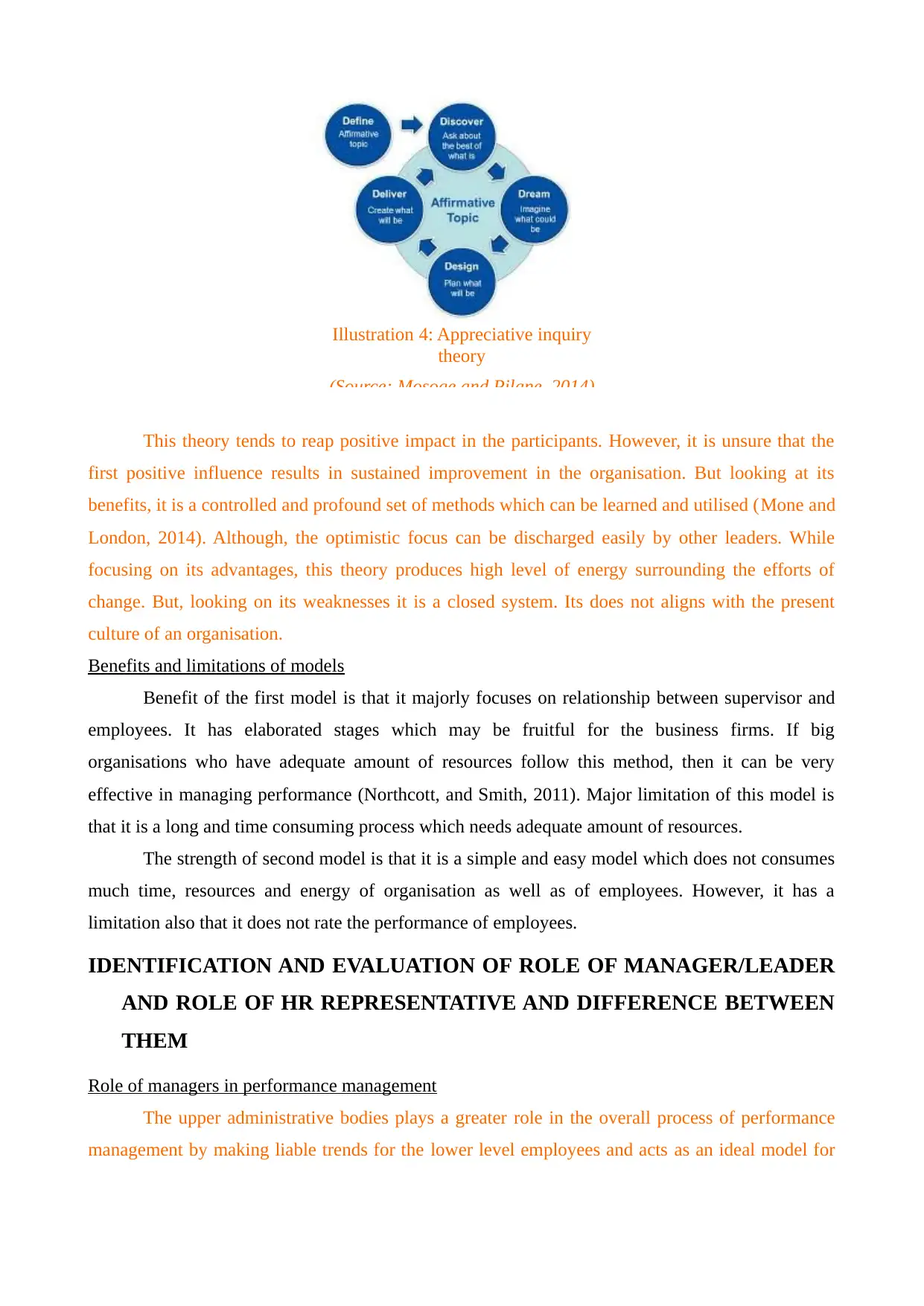
This theory tends to reap positive impact in the participants. However, it is unsure that the
first positive influence results in sustained improvement in the organisation. But looking at its
benefits, it is a controlled and profound set of methods which can be learned and utilised (Mone and
London, 2014). Although, the optimistic focus can be discharged easily by other leaders. While
focusing on its advantages, this theory produces high level of energy surrounding the efforts of
change. But, looking on its weaknesses it is a closed system. Its does not aligns with the present
culture of an organisation.
Benefits and limitations of models
Benefit of the first model is that it majorly focuses on relationship between supervisor and
employees. It has elaborated stages which may be fruitful for the business firms. If big
organisations who have adequate amount of resources follow this method, then it can be very
effective in managing performance (Northcott, and Smith, 2011). Major limitation of this model is
that it is a long and time consuming process which needs adequate amount of resources.
The strength of second model is that it is a simple and easy model which does not consumes
much time, resources and energy of organisation as well as of employees. However, it has a
limitation also that it does not rate the performance of employees.
IDENTIFICATION AND EVALUATION OF ROLE OF MANAGER/LEADER
AND ROLE OF HR REPRESENTATIVE AND DIFFERENCE BETWEEN
THEM
Role of managers in performance management
The upper administrative bodies plays a greater role in the overall process of performance
management by making liable trends for the lower level employees and acts as an ideal model for
Illustration 4: Appreciative inquiry
theory
(Source: Mosoge and Pilane, 2014)
first positive influence results in sustained improvement in the organisation. But looking at its
benefits, it is a controlled and profound set of methods which can be learned and utilised (Mone and
London, 2014). Although, the optimistic focus can be discharged easily by other leaders. While
focusing on its advantages, this theory produces high level of energy surrounding the efforts of
change. But, looking on its weaknesses it is a closed system. Its does not aligns with the present
culture of an organisation.
Benefits and limitations of models
Benefit of the first model is that it majorly focuses on relationship between supervisor and
employees. It has elaborated stages which may be fruitful for the business firms. If big
organisations who have adequate amount of resources follow this method, then it can be very
effective in managing performance (Northcott, and Smith, 2011). Major limitation of this model is
that it is a long and time consuming process which needs adequate amount of resources.
The strength of second model is that it is a simple and easy model which does not consumes
much time, resources and energy of organisation as well as of employees. However, it has a
limitation also that it does not rate the performance of employees.
IDENTIFICATION AND EVALUATION OF ROLE OF MANAGER/LEADER
AND ROLE OF HR REPRESENTATIVE AND DIFFERENCE BETWEEN
THEM
Role of managers in performance management
The upper administrative bodies plays a greater role in the overall process of performance
management by making liable trends for the lower level employees and acts as an ideal model for
Illustration 4: Appreciative inquiry
theory
(Source: Mosoge and Pilane, 2014)
⊘ This is a preview!⊘
Do you want full access?
Subscribe today to unlock all pages.

Trusted by 1+ million students worldwide
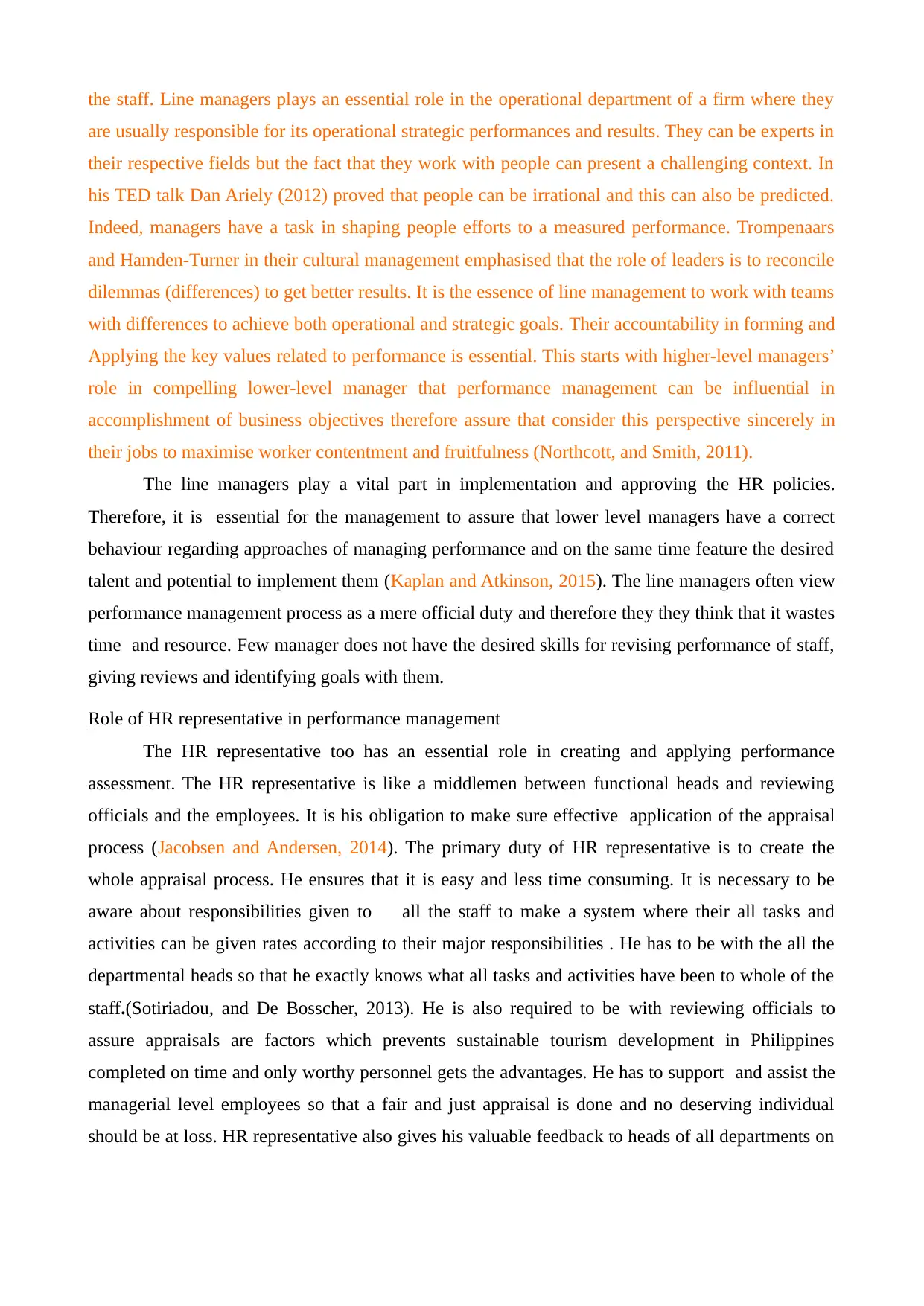
the staff. Line managers plays an essential role in the operational department of a firm where they
are usually responsible for its operational strategic performances and results. They can be experts in
their respective fields but the fact that they work with people can present a challenging context. In
his TED talk Dan Ariely (2012) proved that people can be irrational and this can also be predicted.
Indeed, managers have a task in shaping people efforts to a measured performance. Trompenaars
and Hamden-Turner in their cultural management emphasised that the role of leaders is to reconcile
dilemmas (differences) to get better results. It is the essence of line management to work with teams
with differences to achieve both operational and strategic goals. Their accountability in forming and
Applying the key values related to performance is essential. This starts with higher-level managers’
role in compelling lower-level manager that performance management can be influential in
accomplishment of business objectives therefore assure that consider this perspective sincerely in
their jobs to maximise worker contentment and fruitfulness (Northcott, and Smith, 2011).
The line managers play a vital part in implementation and approving the HR policies.
Therefore, it is essential for the management to assure that lower level managers have a correct
behaviour regarding approaches of managing performance and on the same time feature the desired
talent and potential to implement them (Kaplan and Atkinson, 2015). The line managers often view
performance management process as a mere official duty and therefore they they think that it wastes
time and resource. Few manager does not have the desired skills for revising performance of staff,
giving reviews and identifying goals with them.
Role of HR representative in performance management
The HR representative too has an essential role in creating and applying performance
assessment. The HR representative is like a middlemen between functional heads and reviewing
officials and the employees. It is his obligation to make sure effective application of the appraisal
process (Jacobsen and Andersen, 2014). The primary duty of HR representative is to create the
whole appraisal process. He ensures that it is easy and less time consuming. It is necessary to be
aware about responsibilities given to all the staff to make a system where their all tasks and
activities can be given rates according to their major responsibilities . He has to be with the all the
departmental heads so that he exactly knows what all tasks and activities have been to whole of the
staff.(Sotiriadou, and De Bosscher, 2013). He is also required to be with reviewing officials to
assure appraisals are factors which prevents sustainable tourism development in Philippines
completed on time and only worthy personnel gets the advantages. He has to support and assist the
managerial level employees so that a fair and just appraisal is done and no deserving individual
should be at loss. HR representative also gives his valuable feedback to heads of all departments on
are usually responsible for its operational strategic performances and results. They can be experts in
their respective fields but the fact that they work with people can present a challenging context. In
his TED talk Dan Ariely (2012) proved that people can be irrational and this can also be predicted.
Indeed, managers have a task in shaping people efforts to a measured performance. Trompenaars
and Hamden-Turner in their cultural management emphasised that the role of leaders is to reconcile
dilemmas (differences) to get better results. It is the essence of line management to work with teams
with differences to achieve both operational and strategic goals. Their accountability in forming and
Applying the key values related to performance is essential. This starts with higher-level managers’
role in compelling lower-level manager that performance management can be influential in
accomplishment of business objectives therefore assure that consider this perspective sincerely in
their jobs to maximise worker contentment and fruitfulness (Northcott, and Smith, 2011).
The line managers play a vital part in implementation and approving the HR policies.
Therefore, it is essential for the management to assure that lower level managers have a correct
behaviour regarding approaches of managing performance and on the same time feature the desired
talent and potential to implement them (Kaplan and Atkinson, 2015). The line managers often view
performance management process as a mere official duty and therefore they they think that it wastes
time and resource. Few manager does not have the desired skills for revising performance of staff,
giving reviews and identifying goals with them.
Role of HR representative in performance management
The HR representative too has an essential role in creating and applying performance
assessment. The HR representative is like a middlemen between functional heads and reviewing
officials and the employees. It is his obligation to make sure effective application of the appraisal
process (Jacobsen and Andersen, 2014). The primary duty of HR representative is to create the
whole appraisal process. He ensures that it is easy and less time consuming. It is necessary to be
aware about responsibilities given to all the staff to make a system where their all tasks and
activities can be given rates according to their major responsibilities . He has to be with the all the
departmental heads so that he exactly knows what all tasks and activities have been to whole of the
staff.(Sotiriadou, and De Bosscher, 2013). He is also required to be with reviewing officials to
assure appraisals are factors which prevents sustainable tourism development in Philippines
completed on time and only worthy personnel gets the advantages. He has to support and assist the
managerial level employees so that a fair and just appraisal is done and no deserving individual
should be at loss. HR representative also gives his valuable feedback to heads of all departments on
Paraphrase This Document
Need a fresh take? Get an instant paraphrase of this document with our AI Paraphraser
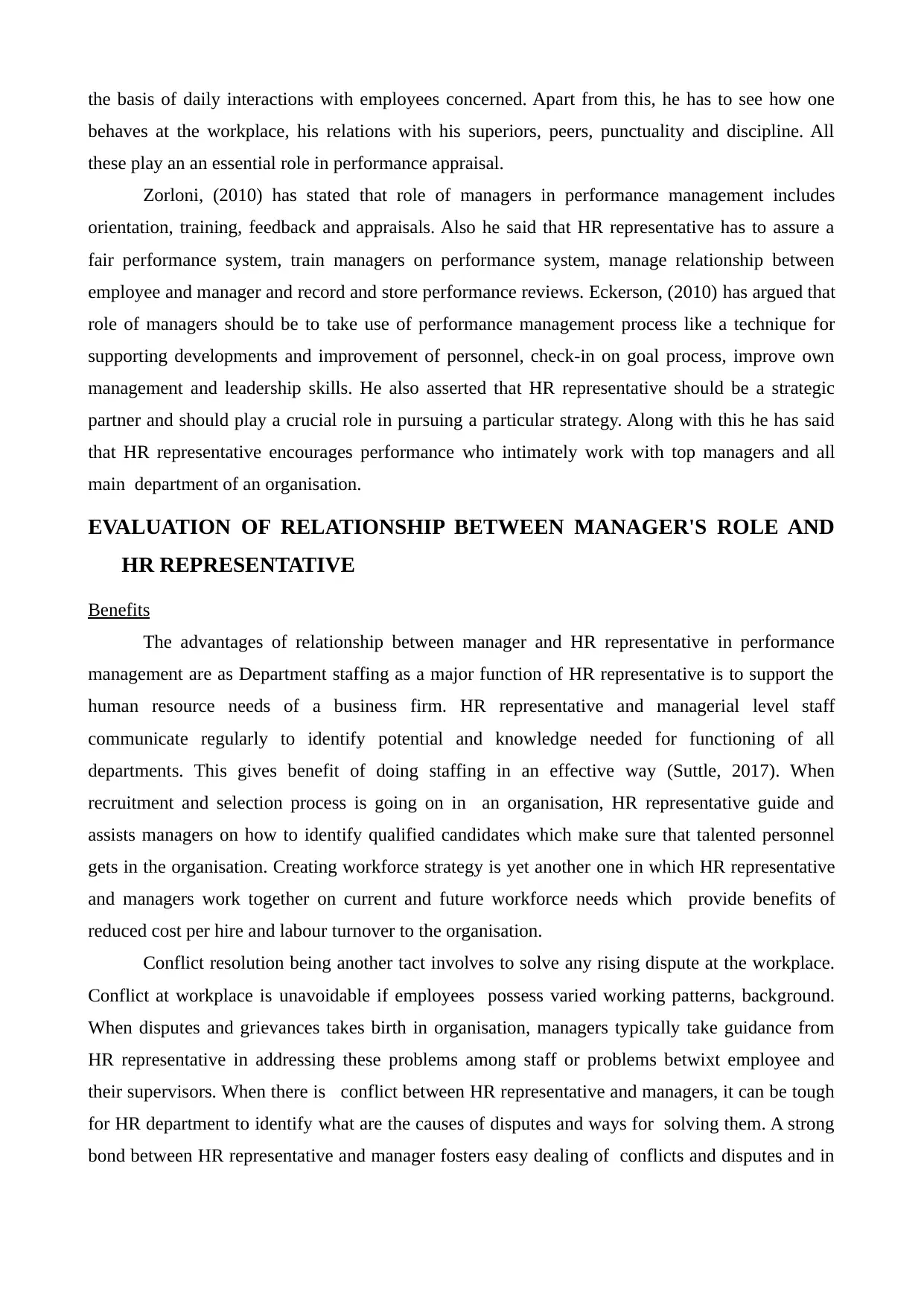
the basis of daily interactions with employees concerned. Apart from this, he has to see how one
behaves at the workplace, his relations with his superiors, peers, punctuality and discipline. All
these play an an essential role in performance appraisal.
Zorloni, (2010) has stated that role of managers in performance management includes
orientation, training, feedback and appraisals. Also he said that HR representative has to assure a
fair performance system, train managers on performance system, manage relationship between
employee and manager and record and store performance reviews. Eckerson, (2010) has argued that
role of managers should be to take use of performance management process like a technique for
supporting developments and improvement of personnel, check-in on goal process, improve own
management and leadership skills. He also asserted that HR representative should be a strategic
partner and should play a crucial role in pursuing a particular strategy. Along with this he has said
that HR representative encourages performance who intimately work with top managers and all
main department of an organisation.
EVALUATION OF RELATIONSHIP BETWEEN MANAGER'S ROLE AND
HR REPRESENTATIVE
Benefits
The advantages of relationship between manager and HR representative in performance
management are as Department staffing as a major function of HR representative is to support the
human resource needs of a business firm. HR representative and managerial level staff
communicate regularly to identify potential and knowledge needed for functioning of all
departments. This gives benefit of doing staffing in an effective way (Suttle, 2017). When
recruitment and selection process is going on in an organisation, HR representative guide and
assists managers on how to identify qualified candidates which make sure that talented personnel
gets in the organisation. Creating workforce strategy is yet another one in which HR representative
and managers work together on current and future workforce needs which provide benefits of
reduced cost per hire and labour turnover to the organisation.
Conflict resolution being another tact involves to solve any rising dispute at the workplace.
Conflict at workplace is unavoidable if employees possess varied working patterns, background.
When disputes and grievances takes birth in organisation, managers typically take guidance from
HR representative in addressing these problems among staff or problems betwixt employee and
their supervisors. When there is conflict between HR representative and managers, it can be tough
for HR department to identify what are the causes of disputes and ways for solving them. A strong
bond between HR representative and manager fosters easy dealing of conflicts and disputes and in
behaves at the workplace, his relations with his superiors, peers, punctuality and discipline. All
these play an an essential role in performance appraisal.
Zorloni, (2010) has stated that role of managers in performance management includes
orientation, training, feedback and appraisals. Also he said that HR representative has to assure a
fair performance system, train managers on performance system, manage relationship between
employee and manager and record and store performance reviews. Eckerson, (2010) has argued that
role of managers should be to take use of performance management process like a technique for
supporting developments and improvement of personnel, check-in on goal process, improve own
management and leadership skills. He also asserted that HR representative should be a strategic
partner and should play a crucial role in pursuing a particular strategy. Along with this he has said
that HR representative encourages performance who intimately work with top managers and all
main department of an organisation.
EVALUATION OF RELATIONSHIP BETWEEN MANAGER'S ROLE AND
HR REPRESENTATIVE
Benefits
The advantages of relationship between manager and HR representative in performance
management are as Department staffing as a major function of HR representative is to support the
human resource needs of a business firm. HR representative and managerial level staff
communicate regularly to identify potential and knowledge needed for functioning of all
departments. This gives benefit of doing staffing in an effective way (Suttle, 2017). When
recruitment and selection process is going on in an organisation, HR representative guide and
assists managers on how to identify qualified candidates which make sure that talented personnel
gets in the organisation. Creating workforce strategy is yet another one in which HR representative
and managers work together on current and future workforce needs which provide benefits of
reduced cost per hire and labour turnover to the organisation.
Conflict resolution being another tact involves to solve any rising dispute at the workplace.
Conflict at workplace is unavoidable if employees possess varied working patterns, background.
When disputes and grievances takes birth in organisation, managers typically take guidance from
HR representative in addressing these problems among staff or problems betwixt employee and
their supervisors. When there is conflict between HR representative and managers, it can be tough
for HR department to identify what are the causes of disputes and ways for solving them. A strong
bond between HR representative and manager fosters easy dealing of conflicts and disputes and in
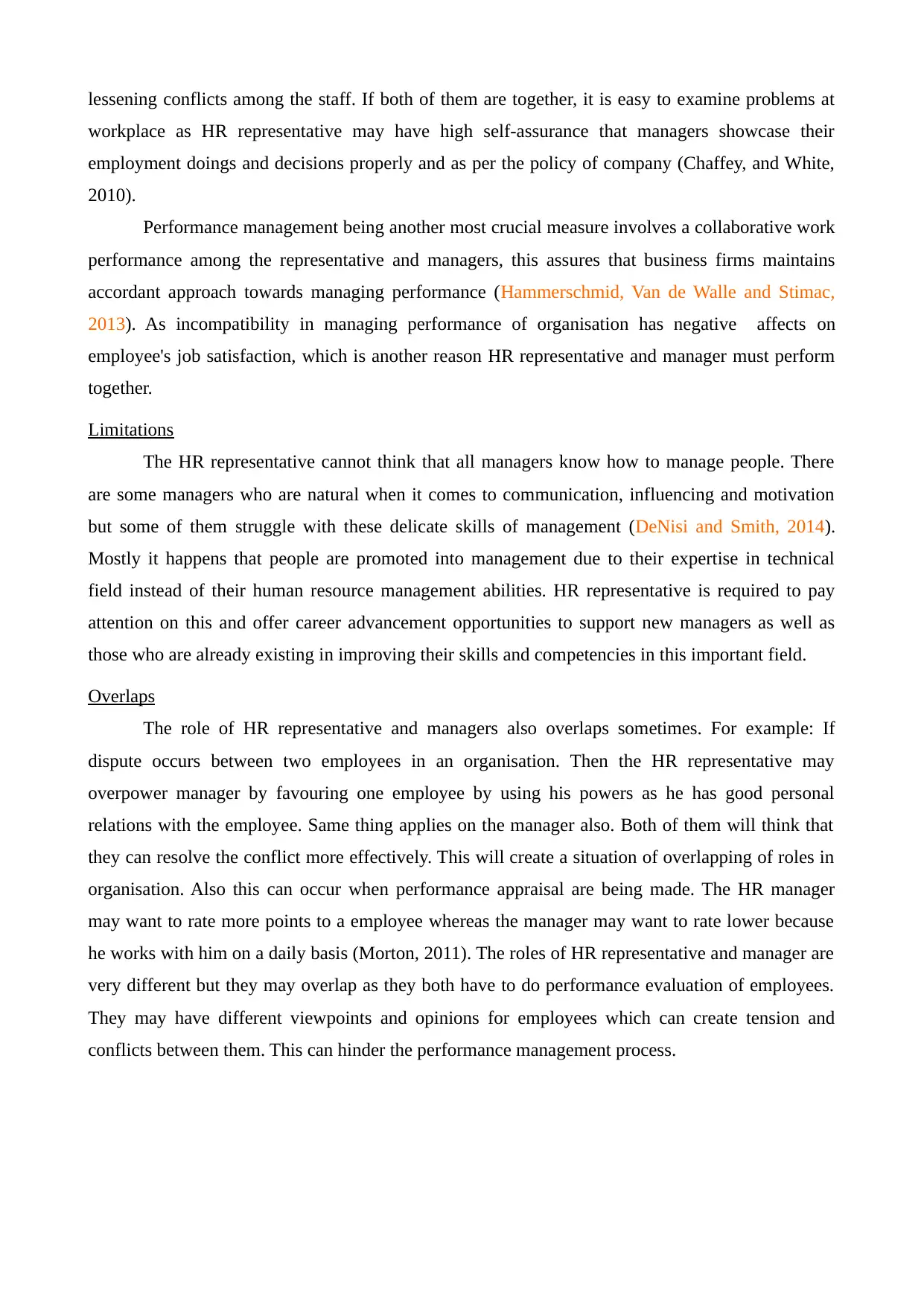
lessening conflicts among the staff. If both of them are together, it is easy to examine problems at
workplace as HR representative may have high self-assurance that managers showcase their
employment doings and decisions properly and as per the policy of company (Chaffey, and White,
2010).
Performance management being another most crucial measure involves a collaborative work
performance among the representative and managers, this assures that business firms maintains
accordant approach towards managing performance (Hammerschmid, Van de Walle and Stimac,
2013). As incompatibility in managing performance of organisation has negative affects on
employee's job satisfaction, which is another reason HR representative and manager must perform
together.
Limitations
The HR representative cannot think that all managers know how to manage people. There
are some managers who are natural when it comes to communication, influencing and motivation
but some of them struggle with these delicate skills of management (DeNisi and Smith, 2014).
Mostly it happens that people are promoted into management due to their expertise in technical
field instead of their human resource management abilities. HR representative is required to pay
attention on this and offer career advancement opportunities to support new managers as well as
those who are already existing in improving their skills and competencies in this important field.
Overlaps
The role of HR representative and managers also overlaps sometimes. For example: If
dispute occurs between two employees in an organisation. Then the HR representative may
overpower manager by favouring one employee by using his powers as he has good personal
relations with the employee. Same thing applies on the manager also. Both of them will think that
they can resolve the conflict more effectively. This will create a situation of overlapping of roles in
organisation. Also this can occur when performance appraisal are being made. The HR manager
may want to rate more points to a employee whereas the manager may want to rate lower because
he works with him on a daily basis (Morton, 2011). The roles of HR representative and manager are
very different but they may overlap as they both have to do performance evaluation of employees.
They may have different viewpoints and opinions for employees which can create tension and
conflicts between them. This can hinder the performance management process.
workplace as HR representative may have high self-assurance that managers showcase their
employment doings and decisions properly and as per the policy of company (Chaffey, and White,
2010).
Performance management being another most crucial measure involves a collaborative work
performance among the representative and managers, this assures that business firms maintains
accordant approach towards managing performance (Hammerschmid, Van de Walle and Stimac,
2013). As incompatibility in managing performance of organisation has negative affects on
employee's job satisfaction, which is another reason HR representative and manager must perform
together.
Limitations
The HR representative cannot think that all managers know how to manage people. There
are some managers who are natural when it comes to communication, influencing and motivation
but some of them struggle with these delicate skills of management (DeNisi and Smith, 2014).
Mostly it happens that people are promoted into management due to their expertise in technical
field instead of their human resource management abilities. HR representative is required to pay
attention on this and offer career advancement opportunities to support new managers as well as
those who are already existing in improving their skills and competencies in this important field.
Overlaps
The role of HR representative and managers also overlaps sometimes. For example: If
dispute occurs between two employees in an organisation. Then the HR representative may
overpower manager by favouring one employee by using his powers as he has good personal
relations with the employee. Same thing applies on the manager also. Both of them will think that
they can resolve the conflict more effectively. This will create a situation of overlapping of roles in
organisation. Also this can occur when performance appraisal are being made. The HR manager
may want to rate more points to a employee whereas the manager may want to rate lower because
he works with him on a daily basis (Morton, 2011). The roles of HR representative and manager are
very different but they may overlap as they both have to do performance evaluation of employees.
They may have different viewpoints and opinions for employees which can create tension and
conflicts between them. This can hinder the performance management process.
⊘ This is a preview!⊘
Do you want full access?
Subscribe today to unlock all pages.

Trusted by 1+ million students worldwide
1 out of 17
Related Documents
Your All-in-One AI-Powered Toolkit for Academic Success.
+13062052269
info@desklib.com
Available 24*7 on WhatsApp / Email
![[object Object]](/_next/static/media/star-bottom.7253800d.svg)
Unlock your academic potential
Copyright © 2020–2025 A2Z Services. All Rights Reserved. Developed and managed by ZUCOL.



![[Course Name] Coursework: Employee Motivation and HR Technology](/_next/image/?url=https%3A%2F%2Fdesklib.com%2Fmedia%2Fimages%2Fma%2F2ba519af49b147e5b2dd5f7233c67895.jpg&w=256&q=75)

